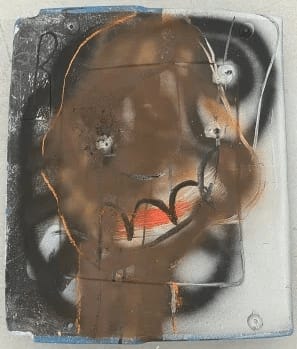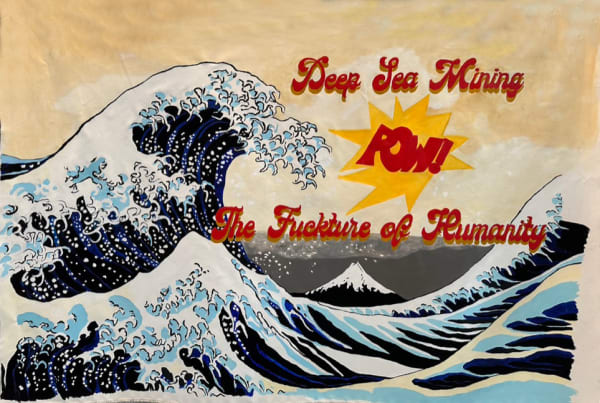-
the future of america
a collective exhibition
Curated by analya meneses imber and claudia taboada
September 28 - november 14, 2024
little river
274 ne 67th st, miami fl, 33138
-

Luis Cruz Azaceta
A Question of Color, Justice and freedom in our Democrazy, 2019As we stand on the threshold of a new era, The Future of America challenges us to envision a nation that lives up to its founding ideals of liberty, equality, and justice for all. Through a diverse array of artistic mediums, each artist offers a unique interpretation of the American experience. The Future of America works as a platform for critical dialogue and introspection. Addressing pressing issues such as social justice, environmental sustainability, political reform, and economic equity, the exhibition sparks conversations about the nation's challenges and the pathways toward a more equitable and inclusive future.
Featured artists: Jairo Alfonso, José Bedia, Carola Bravo, Maria Cristina Carbonell, Luis Cruz Azaceta, Laddie John Dill, Carlos Estevez, Carlos Garaicoa, Nelson Jalil, Tony Labat, Raul Martinez, Jim Morphesis, Yucef Merhi, Sandra Ramos, Leticia Sanchez Toledo, and Chantae W. Wright.
-
-

-

Jose Bedia
Cumpliendo un Destino Inexorable, 2010The Future of America, an exploration into the diverse and dynamic narratives that shape the destiny of the United States now that the electoral process has polarized America more than ever. Curated by Analya Meneses Imber and Claudia Taboada, this exhibition aims to accompany a current event that has been developing for several years with previous candidacies. Against the backdrop of impending elections, this exhibition serves as a poignant reflection on the myriad possibilities and challenges that lie ahead for the nation.
Drawing inspiration from the notion of America as a melting pot, this exhibition celebrates the tapestry of cultures, traditions, and perspectives that converge within its borders. From the shores of Ellis Island to the bustling streets of metropolitan hubs, America stands as a beacon of hope and opportunity, welcoming individuals from every corner of the globe.
-

Laddie John Dill
1984, 1979Acrylic, cement and glass on wood panel
40 x 84 in
101.6 x 213.36 cm -

-

-

-
-

Yucef Merhi
Color Bars, 2024Artist Statements
This work explores the language of television and the nature of politics in the United States: a binary structure that repeats itself election after election, leading to a state of predictability and numbness.
A color bar is a strip on a screen display showing a range of colors. It is used to ensure that all colors are displayed correctly, and it is also used for testing and calibrating screens. In this case, the colors follow a specific color spectrum of blues and reds, referring to the Democratic and Republican parties.
Color bar is also a social system in which Black and other nonwhite people are denied access to the same rights, opportunities, and facilities as white people.
In both cases, the binary presence is clear, steady, and repetitive.
Yucef Merhi
-

-

-

Sandra Ramos
Soñando otra Itaca, 2012Mixed media on paper
33 1/2 x 51 1/2 in
85.1 x 130.8 cm
Ed 4 of 30 -
-
About the Exhibition
By Robert BorlenghiIn the 1970s, I decided to ask established artists to do a painting for me, using their view of the future of America. I called the project “Collection 84.”
Joe Goode was the first artist; he gave me a black painting with scratches and cuts. Ed Ruscha refused to do on canvas the stylized machine-like 1984 he had done on paper but made a painting that was part of his retrospective at the Modern in San Francisco (“In the Year of Our Lord 1984”). Carlos Almaraz, Lita Albuquerque, Tony Berlant, Laddie John Dill, Eric Orr, and Jim Morphesis followed.
Next was Mel Ramos, who created a carnal statue of liberty inspired by Ingres. She had a minimal American flag wrapped around her hips, the colors quite faded, and she suffered under the weight of the lantern.
In those days, I served on the Acquisitions Committee for Contemporary Art at LACMA, so I discussed my project with the head curator, Maurice Tuchman. He told me that the idea was “stupid,” as anything could happen by 1984 that could change the artists’ predictions… I was in my 30s and too easily influenced by a big-time curator, so I stopped the project. He had not understood it.
Sam Francis had just done a painting (with a black background), Wayne Thiebaud had agreed to do one, and I had spoken with Baldessari and Billy Al Bengston; those paintings were never done…
There were also cases where the artists refused to do a painting: Ernest Trova, whom I visited in St. Louis, had decided he was at that point only a sculptor; Basquiat wanted me to buy a piece from his exhibit in Los Angeles, but I wanted one done expressly for the collection, and despite Gagosian’s best efforts I did not (regrettably…) change my mind.
Claudia Taboada, director of Pan American Art Projects, decided that we should give artists of today the opportunity of offering a new look at the future of America; she invited Analya Meneses Imber to join her in the re-imagination of the project. We included with their views a prophetic painting by Jose Bedia and a mysterious one by Luis Cruz Azaceta, chosen by him. Morphesis and Dill served as bridges between the original series and these new materializations of the artists’ sense of the future. What the groups from different periods have in common is the enthusiasm with which they accepted the challenge, regardless of their age. We appreciate the sincerity of their intent, a testimonial of the new age…
Copyright © 2025 Pan American Art Projects
Facebook, opens in a new tab.
Twitter, opens in a new tab.
Youtube, opens in a new tab.
Instagram, opens in a new tab.
LinkedIn, opens in a new tab.
Artsy, opens in a new tab.
Send an email
Ver en Google Maps
This website uses cookies
This site uses cookies to help make it more useful to you. Please contact us to find out more about our Cookie Policy.






























